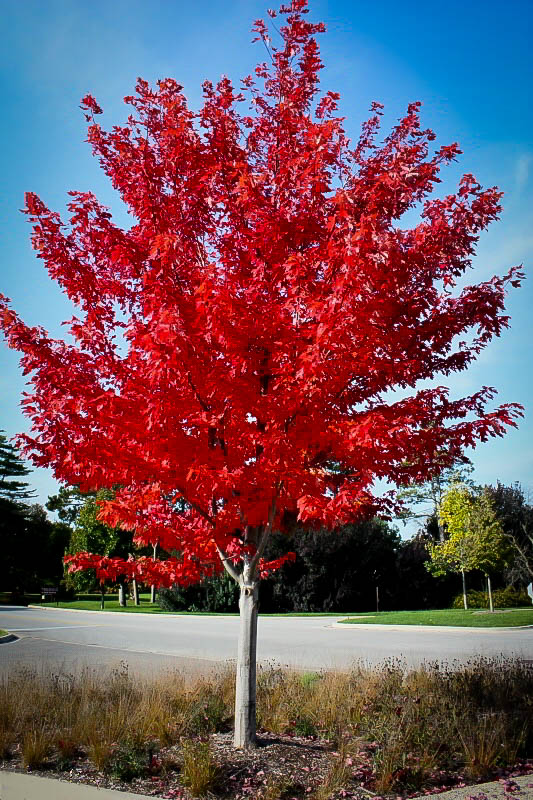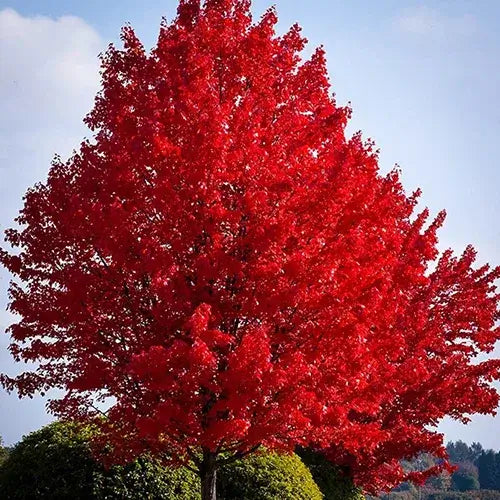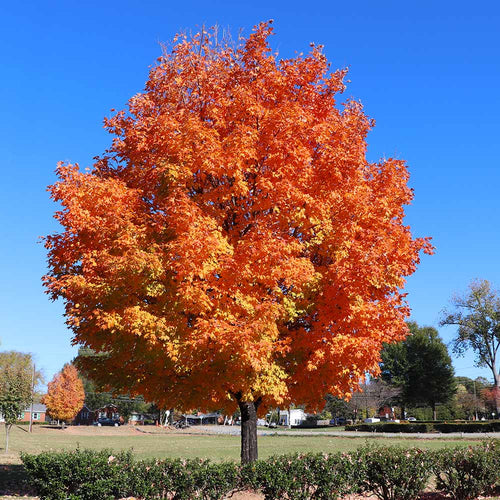When leaves change color and eventually fall off the tree, did you know that not all trees have vibrant fall foliage?
Some trees are utterly devoid of color during autumn.
In vibrant fall foliage, leaves that change color in autumn and remain colorful until they fall off the tree. While most trees have some degree of fall color, some stand out more than others.
You think of fall; if you want to add a splash of color to your landscape this autumn, consider planting one of these five trees and enjoy the beautiful foliage.

Red Maple Tree
The Red Maple Tree is one of North America's most popular and well-known trees. It is a deciduous tree that loses its leaves every year. Many people identify this tree by the name Soft maple.
The red maple is a relatively small tree, reaching a height of 30-35 feet (9-10 meters). The bark of the red maple tree becomes rigid and scaly with time, making it solid and beautiful.
The leaves of the red maple are arranged in pairs on the stem. They are simple, meaning they are not divided into smaller leaflets. The leaves are 3-6 inches (8-15 cm) long and 2-4 inches (5-10 cm) wide.
They are bright green on the top and duller green on the bottom.
The red oak tree is undoubtedly the best pick for vibrant fall foliage. The fruit of the red maple is a tiny, reddish-brown seed with a wing attached. The seeds are released in late spring or early summer and are dispersed by the wind.
Red maples can be found in forests throughout eastern North America. They prefer moist, well-drained soils but can also grow in drier conditions.
Tips for Growing Red Oak Tree
Plant in the right location
Red maples need full sun to grow and thrive. They also prefer moist, well-drained soils but can tolerate some flooding.
Amend the soil before planting
Amending the soil with compost will help the red maple tree get established more quickly.
Water regularly
Water the red maple tree regularly, especially the first year after planting. Once established, the tree is relatively drought-tolerant.
Fertilize every year
Fertilize the red maple tree every year with a slow-release fertilizer. Apply compost around the base of the tree each spring.
Prune the tree in late winter or early spring
Prune the red maple tree in late winter or early spring before new growth begins. Remove any dead, diseased, or damaged growth. It's also advisable to remove suckers that may be growing at the base of the tree.
Red maple is a striking tree that will add color and interest to your landscape. With proper care, it will withstand harsh weather for many years.
Red Sunset Maple Tree
Red Sunset Maple Tree is one of the most popular and widely grown maples. Being a deciduous tree that is native to North America. The leaves of this tree are opposite, and the inflorescence consists of tiny clusters of yellow-green flowers. The fruit is a samara, which is a winged seed that is dispersed by the wind.
Red Sunset Maple Tree is an excellent choice for those looking for a fast-growing maple tree. Red Maple trees reach heights of 30-60 feet with a spread of 20 to 30 feet at maturity.
Grows in full sun and tolerates partial shade. It prefers well-drained soils but is tolerant of clay soils. Red Sunset Maple Tree is also relatively drought-tolerant once it is established.
This maple tree is relatively disease and pest-free. However, it can be susceptible to foliar diseases such as tar spots and verticillium wilt. It is also essential to keep an eye out for aphids, scales, and Japanese beetles, which can cause damage to the leaves of this tree.
Red Sunset Maple Tree is a beautiful tree that provides stunning fall color. The leaves turn various shades, including red, orange, and yellow. This tree is also known for its excellent wood quality, which makes it a popular choice for furniture and cabinetry.
If you are looking for a fast-growing maple tree with beautiful fall color, the Red Sunset Maple Tree is an excellent choice. It is easy to care for and does not require much maintenance and looks beautiful during fall.
Tips for growing Red Sunset Maple Tree
Plant in the right location
Red Sunset Maple Tree prefers full sun but can tolerate partial shade. It also prefers well-drained soils but is tolerant of clay soils.
Water regularly
This tree is relatively drought-tolerant once it is established. However, you will need to water it regularly during the first few years after planting. The solid should be moist but not soggy as it can weaken the roots.
Fertilize annually
Fertilize your Red Sunset Maple Tree annually with a balanced fertilizer. This will make your tree beautiful, and thru apply the fertilizer in early spring before new growth begins.
Prune as needed
Pruning is unnecessary for this tree, but you can prune it if you want to control its size or shape. Pruning can be done during late winter or early spring before new growth begins.
Protect from pests and diseases
Red Sunset Maple Tree is relatively disease and pest-free. However, it can be susceptible to foliar diseases such as tar spots and verticillium wilt.
It is also essential to keep an eye out for aphids, scales, and Japanese beetles, which can cause damage to the leaves of your tree. If you notice any of these pests or diseases, treat them immediately.
Tulip Tree
The Tulip Tree is a beautiful tree native to the eastern United States. It is most commonly found in the Appalachian Mountains but also in other parts of the country.
The Tulip Tree Silver gets its name from its beautiful silver-colored leaves, shaped like tulips. The tree grows to be about 60 feet tall and has a trunk about 2 feet in diameter.
The Tulip Tree Silver leaves are elliptical and about 6 inches long and 4 inches wide. The flowers of the Tulip Tree Silver are greenish-yellow in color and have five petals. The blooming period occurs in late spring or early summer.
The Tulip Tree Silver is an essential food source for many animals, including squirrels, rabbits, birds, and deer. The tree is also used as a nesting site for many birds.
The Tulip Tree Silver is a popular landscape choice because of its beautiful silver leaves and ability to attract wildlife. The tree is relatively easy to care for and does not require much maintenance.
However, the Tulip Tree Silver needs full sun and moist soil to thrive.
##Tips for growing Tulip Tree Silver
- Plant in full sun for best results
- Moist soil is best, but the tree can tolerate some drought
- Give the tree adequate r- it can reach up to 60 feet tall!
The Tulip Tree Silver is a beautiful and versatile tree perfect for any landscape. With its beautiful silver leaves and ability to attract wildlife, the Tulip Tree Silver room to grow is an excellent choice for anyone looking to add some beauty to their yard.
Maple Tree
Maple trees are hardy grown in North America. Trees. They are known for their beautiful fall colors and their delicious syrup. Maple trees are also a great source of lumber.
There are all types, but sugar maple, red maple, and silver maple are the most common. Maple trees can grow huge, up to 100 feet tall. They have a widespread root system that can make them difficult to transplant.
Maple trees prefer to grow in areas with full sun and well-drained soil. They are not very tolerant of shade or wet conditions. Maple trees are susceptible to diseases and pests, including aphids, scales, and borers.
Most maple trees are easy to care for and require little maintenance. They should be fertilized every few years and pruned in the late winter or early spring. Maple trees can live for many years, with some specimens reaching over 200 years old.
A maple tree is an excellent choice if you want a beautiful tree to add to your landscape and experience. s of maple trees. They provide you with years of enjoyment.
Sugar Maple Tree
The sugar maple is also one of the most popular trees for fall foliage, and it's easy to see why. These towering trees are known for their bright red and orange leaves, making a stunning display in any landscape.
Sugar Maple trees are native to the United States, so they'll do best in that region. They're also relatively low-maintenance, so you won't have to put in a lot of work to keep them looking their best.
When it comes to planting, sugar maples prefer well-drained soils and full sun. They're also tolerant of a wide range of pH levels, so you shouldn't have trouble finding a spot that suits them.
Once they're established, they don't need much water or fertilizer. However, if you want to encourage vigorous growth, you can give them a little extra TLC during the growing season.
As far as pruning goes, sugar maples don't require much. You can remove dead or damaged branches anytime and do some shaping if you want to control the tree's size or shape.
Sugar maple is an excellent option if you're looking for a beautiful, low-maintenance tree for your landscape. With its bright fall foliage and easy-care nature, it's sure to add beauty and value to your home.
Tips for growing sugar maple trees
Planting trees is not easy, and every plant requires a different way of maintenance. Here are tips for growing a sugar maple tree on your landscape.
Choose a location.
It prefers full sun so pick a spot that meets those requirements. When choosing a planting site, you'll also need to consider the tree's mature size.
Once you've selected a location, it's time to prepare the soil.
You'll need to loosen the top 12 inches of soil and add some compost or other organic matter. This will help the tree roots establish themselves and encourage vigorous growth. Moreover, mix the amendments well so they're evenly distributed.
It's time to plant your tree.
You'll need to dig a hole twice as wide as the tree's root ball and just deep enough to cover it.
After planting, water this good.
It would help if you mulched around the tree's base to help retain moisture and prevent weeds from growing.
Once your tree is established, you won't need to water it often.
Too much moisture can be detrimental to sugar maples. They prefer drier conditions, so only water when the soil is dry to the touch.




















































